Magazine Archive
Home -> Magazines -> Issues -> Articles in this issue -> View
Vox Guitars and Basses | |
Article from Electronics & Music Maker, April 1983 | |
Nearly two years ago, after Vox Ltd., a new company, had been turning out the famed Vox AC amps and combos for some time, they suddenly announced that they would launch a new series of Vox guitars. I must admit I got just a bit excited. All sorts of possibilities began to loom in my mind, but to understand these possibilities you need to know a little about the previous history of Vox guitars - made then, of course, in England.
While the first Vox six-strings were not particularly distinctive, and looked rather like other standard European fare of the early 1960s (i.e. boring), the American influence began to creep in towards the middle of the decade and mid-period Vox models were among the earliest blatant Fender copies.
But the old Vox company apart from their amps will doubtless be remembered mainly by older musicians (and Dave Wakeling) for the odd-shaped Phantom models, first coming in a strange four-sided shape, later settling down to the more famous 'teardrop' shape guitars and basses. Then there was the Guitar Organ, a bizarre forerunner of the guitar synth, in a way, and a decidedly unsuccessful if legendary instrument to boot. But all power to Vox for trying it on!
All this ingenuity and invention eventually dwindled, however, and Vox guitars ceased to be around the early 1970s. Now, perhaps, you've an inkling of why I got so excited back in 1981 at the prospect of a revamped Vox range. I even rather foolishly expected British-made guitars.
What Vox have is a range of some seven guitars and two basses (counting finish variations and fingerboard options) all made, inevitably, in Japan and rather, well, derivative in shape and overall design. It doesn't, however, seem to be a straight case of buying up a line of Jap axes and bunging VOX on the head. Vox Ltd in North London specified what they wanted to a large extent - guitar technician Adrian Legg got some of the wiring configurations together, and a version of the classic Vox headstock shape is incorporated into the design. Pity, though, that we didn't get a Phantom shape on one of the bodies too - maybe Japanese routers can't handle such long curves? Pickups were also Vox-specified, coming from the well-known DiMarzio factory in New York.
Vox Ltd's reason for using Japanese production to assemble the new guitars is spelt out in some of their promotional literature as follows: "The UK, the USA or Japan were the only real contenders. After much searching we chose Japan. Only then did we find the complete combination of production capability, quality, consistency, capacity and cost. So that is where we have set up production." All of which seems fair enough, although I suspect that cost really should head the list.
The range splits now into three groups: three 24¾in-scale guitars; four 25½in-scale guitars; and two basses. The 24¾s are sort of Yamaha-shaped for want of a better reference point, the Standard 24 coming in black or cherry, and the Custom 24 straight-through-neck job arriving in walnut.
The 25½s are Strat-shaped, the Standard 25 coming in black with rosewood or maple fingerboards, and in cherry with rosewood board, while the Custom 25 is a straight-through coming in walnut again. The basses are a black Precision-like Standard Bass, and a similar but straight-through 'honey' finished Custom Bass.
I took a look at a couple of reasonably priced models from the range (they go from about £140 for the cheapest to nearly £300 at the top), the Standard 25 (cherry/rose-wood), which sells for a recommended £159 (inc. VAT), and the Standard Bass, which is yours for a recommended £139 (inc. VAT).
Standard 25

Vox Standard 25 guitar.
First impression: what a tiny guitar! Second impression: but it's heavy/solid. Third impression: Vox have seen a Strat before, once or twice.
But first a quick visual run-down: body finish on the review sample is 'cherry', though it also comes in black. It's not quite a Gibson cherry, but isn't bad, looking a little more cheerful in daylight than it does under electric lights. The scratchplate is slightly yellowed, saving you all that trouble of subjecting it to lung-loads of cigarette smoke, and there are 22 fat frets in the rosewood fingerboard/maple neck, leading up to the Vox headstock. I think the head-stock looks a little cumbersome, but it does provide one of the few links with the Vox past.
On the maple body is a good multipurpose bridge, which will again be relatively familiar to Strat fans, and indeed many others. Strings are inserted through the back of the body into the bridge block (some claim that this wider area of coupling with the body wood is supposed to give a better sound), and out over the six individual bridge pieces. Each is adjustable for height (action) with two 1.5mm hex-socket screws either side of the string, and for intonation (length) via the standard cross-head sprung-screw located on the back of the 'lip' of the bridge unit. The springs needed a helping push now and again as I set up a reasonable intonation, but the bridge is of a tried-and-tested formula which will serve well.
Also located hereabouts is the device that guitar makers seem to have decided is a distinct requirement for 1983, a tremolo arm. Of course Vox and many others, got there before the rush, and the tremolo arm here - you know that it should accurately be called a vibrato arm, so I won't bore you with that - does its usual pitch-depressing job in commendable fashion. Pitch-return was acceptable.
Pickups are lively DiMarzio FS1 types - three of these are arranged in what can only be described as Strat layout: the bridge pickup angled to accentuate the treble strings' top frequencies. These are controlled by - you guessed - a Strat-like control arrangement: a single master volume pot accompanied by a tone pot each for the middle and front pickups (bridge tone is preset), plus a nearby five-position pickup selector. This gives each pickup, plus the famous 'in-between' settings, not exactly the out-of-phase sounds which some have labelled them, but a useful inclusion nonetheless. You too can sound like Mark Knopfler, as an ad somewhere must go.
Beyond the plastic nut and two string posts are six machine heads (count them) which work well and effortlessly - tuning held accurately except when I had a weak moment of trem-bashing, which is only to be expected.
The guitar is a lively, pokey little instrument, fun for winding up and getting down, but with enough in reserve for those unfashionable enough to desire quality and expression in their playing. Difficult to fault at the price: all I can say is I'd probably go for the black one. And if the colour's your only problem, things must be good.
Standard Bass

Vox Standard Bass guitar.
This is basically, as they say (and no pun intended), a Precision-like instrument with a series/parallel switch added, and the special shape Vox headstock. To balance the design and overall dimensions, the head-stock is larger than on the Standard guitar, and my dislike of the shape increases proportionately. Ah well, I dare say you think it looks lovely.
On to more general looks: the black body and headstock-facing complement the all maple neck with black position dots rather nicely. The impression is of well-presented simplicity, and indeed that characterises this Standard Bass.
Frets are again fat, and 24 of the things sit minding their own business under the overall 34in scale. The maple body sports two controls, an overall volume and an overall tone ('Hatbox' types, as they're called), and the previously mentioned series/parallel switch lurks nearby. In a way this switch seems to have been included with a guitarist's way of thinking in mind (in fact the little pamphlet that comes with the Standard Bass tells you that parallel coils give "a brighter sound more suitable for chord work"), but does nevertheless provide two reasonably distinct sounds - series a little warmer, parallel somewhat cleaner. And if you do want to play chords on a bass, go right ahead.
These controls govern another DiMarzio pickup, the well known P-Bass type. No prizes for guessing what the 'P' stands for, but it is a split four-polepieces-per-two-strings type, and seems to combine high output with reasonable quality, as one has come to expect from DiMarzio.
The bridge is a back-mounting (that's my jargon for "you poke the strings through the hole in the lip", by the way), standard type, again adjustable for height and length with the same type of screws as for the Standard guitar, mentioned earlier.
Machine heads are closed, chunky, effective types, while back at the maple body the jack socket sits unobtrusively on the side.

Despite my reservations about the bulk of the headstock, the bass balances comfortably on a strap, and seemed equally at home resting on my knee (and who wouldn't?). I must say I found the neck rather a handful, with its rather large cross-section. This is obviously a matter of taste, but personally I do prefer my necks somewhat slinkier.
One has to bear in mind that at this end of the market the maker really is working to a price and that you are not going to be offered too many frills, both cosmetically and sonically. If you're looking for a first-time-buy bass, or maybe for a bass as a secondary instrument, then obviously this is the sort of area and price-range you may well be looking at. Most makers address themselves to this market, so it's worth taking a good look around.
But this is as straightforward a bass as you'll get, it's certainly offered at a good price, and if a cutting, simple sound is what you want then check it out.
If I had to level any criticism at the Vox range on the strength of these two review samples, I would point to a slightly mechanical feel about the instruments - a slight lack of warmth and 'feel'. But here we're beginning to get into a rather subjective argument, and the best I can suggest is that you give the guitars a try for yourself. For another view on a couple of other guitars in the range, see Pete Maydew's review of the Custom Bass and Custom 25 guitar in the December 1981 issue of E&MM.
Publisher: Electronics & Music Maker - Music Maker Publications (UK), Future Publishing.
The current copyright owner/s of this content may differ from the originally published copyright notice.
More details on copyright ownership...
Review by Tony Bacon
Help Support The Things You Love
mu:zines is the result of thousands of hours of effort, and will require many thousands more going forward to reach our goals of getting all this content online.
If you value this resource, you can support this project - it really helps!
Donations for January 2026
Issues donated this month: 0
New issues that have been donated or scanned for us this month.
Funds donated this month: £0.00
All donations and support are gratefully appreciated - thank you.
Magazines Needed - Can You Help?
Do you have any of these magazine issues?
If so, and you can donate, lend or scan them to help complete our archive, please get in touch via the Contribute page - thanks!




